NAB Show Product Review: Signal Processing
We’ve now arrived at the doorstep of another big era of change in the television industry, ushering in UHD imaging, wider color gamuts, high dynamic range and virtualization. Plant infrastructures are changing also; this time from SDI to IP. There’s one element that won’t change though, and that’s the requirement for signal processing.
EAS/CAP
DIGITAL ALERTING SYSTEMS (DAS), a division of Monroe Electronics, partnered with TRIVENI DIGITAL on an ATSC 3.0 Advanced Emergency Alerting (AEA) starter kit for TV broadcasters. It combines DAS’s DASDEC emergency messaging platform and AEA Content Management with Triveni’s Digital GuideBuilder XM signaling and announcement generator, Route/ MMTP encoder and a live source simulator to allow stations to deliver advanced emergency alerts and auxiliary public safety information in both ATSC 1.0 and 3.0 environments.
CLOSED CAPTIONING
COMPROMPTER showcased the latest version of its Caption Central Multi (CCM), featuring a new Speech Engine that provides fast and accurate live voice captioning, with synchronization to the spoken words within two seconds.
EEG introduced the Lexi cloud-hosted automatic speech recognition captioning system which operates automatically in connection with EEG captioning encoders and captioning software to receive program audio, translate it into captions, and provide updating of names, current news events and topics via its cloud environment.
ENCO spotlighted enCaption 3R4 for their enCaption speech-to-text voice technology. It can distinguish between multiple speakers within a single environment, helps to eliminate errors in identifying voices of individuals, saves time and operates without human supervision in live captioning environments.
TELESTREAM announced that its entire suite of captioning and subtitling products now supports IMSC 1.0, the new OTT standard for subtitling and captioning. IMSC 1.0 Timed Text is a requirement for major networks and content distributors standardizing on the IMF file-based delivery format.
VOICEINTERACTION launched the fifth-generation of its Audimus Media system for automatically generating captions for live productions. It provides a cost-effective means for delivering highly accurate captions and ensuring that closed-captioning legal requirements are met.
ENCODERS/DECODERS
AXON DIGITAL DESIGN introduced their eight-channel Synapse NIO440, an Ethernet/SDI bridge that can help broadcasters negotiate the SDI to IP transition. It’s software-upgradable and supports S2059 PTP timing and synchronization.
BBRIGHT debuted their UHD-Decode high-bitrate HEVC contribution decoder, which accommodates 10-bit 4:2:2 signals at up to 120 Mbps, and features TSoIP inputs and quad 3G SDI outputs.
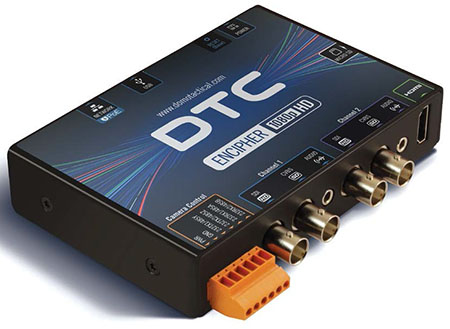
DTC Domo Broadcast Encipher dual-channel encoder
DTC DOMO BROADCAST introduced the Encipher dual-channel encoder for IP that bundles high-quality video, dual HD encoding capability, a compact form factor, operation in a variety of bandwidths, power-over-Ethernet, builtin camera control and options for cellular network integration.
EVERTZ rolled out both the evRemote and 3606FR IP transport streams, designed for remote production. The evRemote provides 120 Gbps switching capability along with up to 12 JPEG2000 encoders and decoders. The 3606FR, meanwhile, supports simultaneous dark fiber and IP transport for multiple signal formats including video, audio and serial data.

For-A Fujitsu IP-HE950 encoder
FOR-A launched the Fujitsu IP-HE950 real-time H.265/HEVC encoder/decoder, which supports 4K contribution feeds, as well as SD and HD video. It automatically identifies signals and adjusts encoding formats, provides real-time HDTV transmission at low bitrates via broadband IP networks and DVB-ASI, offers low latency and robust network error correction, and is contained in a space-saving 1RU half-rack package.
HAIVISION introduced its Makito X encoders and decoders in action, which support HEVC/H.265 and AVC/H.264. They feature low latency and secure transport of HD signals over networks with unpredictable capabilities. Haivision’s HaiGear Labs group also demonstrated encoding software running live 4K60p video via off-the-shelf servers.
HARMONIC targeted ATSC 3.0 at its booth by demonstrating how its Electra X media encoding and new ProStream X stream processing systems can compress broadcasters’ existing ATSC 1.0 channels with greater efficiency, as well as transition to ATSC 3.0 advanced services via a simple software license.
LIVEU showcased its new 4K HEVC Pro Card hardware encoder developed for the company’s LU600 portable video transmission unit. It offers high-quality 1080/4K video, very low-power consumption, easy dynamic bitrate and resolution changes, HEVC and H.264 encoding, can make high-quality copies of the content being transmitted.
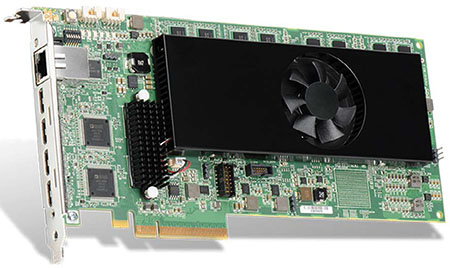
Matrox Maevex 6150 quad encoder card

Nevion Virtuoso
MATROX debuted its new Maevex 6100 series of multistream 4K products, including the 6150 quad encoder appliance which allows users to stream or record as many as four 4K signals at low bitrates. It features zero-latency pass-throughs to workstations, media preview, built-in display for examining device IP and stream addresses and more.
NEVION demonstrated their latest Virtuoso software update for JPEG2000 encoding of 4K and 2K UHD, frame synchronization, PTP synchronization of SMPTE 2022-6 and more.
PRONOLOGY debuted StreamFile Core, a cross-platform standalone application that encodes the multitude of evolving media standards, bridging the gap between IP-based video and legacy file-based workflows.
SOLITON SYSTEMS teamed up with systems integrator and distributor Palma International to develop and exhibit a new H.265-based mobile contribution encoder, which it billed as the world’s smallest. The Smart-telecaster Zao-S is designed to provide reliable HD video transmissions via 3G and 4G cellular networks, and easily fits in users’ pockets with a footprint just slightly larger than that of a smartphone.
VITEC unveiled its new GEN2 HEVC second-generation codec, which the company claims surpasses performances of the next leading contender by some 20 percent.
PROCESSING
AJA demonstrated v13 software that adds HDR support to its Kona 4 desktop I/O card. The company also demo-ed new firmware to support input and real-time encoding of JPEG2000 streams by the Kona IP desktop card.
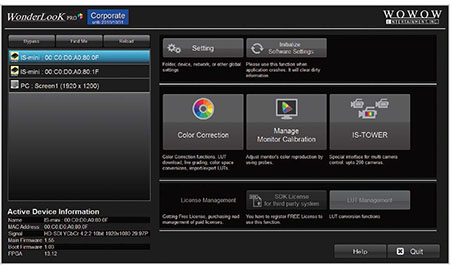
AudioVideo BrandBuilder WonderLook Pro
AUDIOVIDEO BRANDBUILDER showcased the IS-miniX LUT device for the color management of 3G/HD SDI video signals as well as the WonderLook Pro (WLP) a newly developed color management software solution based on FujiFilm technology and designed to help DITs and colorists to resolve any issue in color creation and color management.
AXON DIGITAL DESIGN introduced their software-upgradable eight-channel Synapse NIO440 Ethernet/SDI bridge. It supports eight channels of video, S2110 (TR03), S2059 (PTP) synchronizing and timing, AVB/TSN, and operates bidirectionally.
COBALT DIGITAL debuted their 9991-SDI-to-10GE Encapsulator that offers SDI-to-IP processing as well as AES/analog audio embedding/de-embedding. Cobalt also launched the 9923-DSK-3G downstream keyer/logo generator that works with 3G/HD/SD-SDI and mixes any two SDI key/fill inputs and eight on-board logos.
D2D TECHNOLOGIES introduced the D2Flex 6000, a next-generation MPEG digital video multiplexer and IP gateway. Service components can be selected from any input to create each output.
DVEO unveiled their new miniature low-latency H.264 HDMI encoders and decoders, the Ministreamer HDMI/IP and the Mini DStreamer IP/HDMI.
ERICSSON introduced their fully virtualized video processing platform, the MediaFirst Management Controller. It streamlines control of processing most platforms, provides increased operator flexibility, enables transition to an agile software architecture, and lays the groundwork for expansion into services including UHD, VR/AR, dynamic ad insertion and others.
FOR-A debuted the FA-9600 multipurpose signal processor, featuring dual-channel operation and support for 4K with 12-SDI and HDMI connectivity, along with bidirectional dynamic range conversion between PQ, HLG, S-Log 3 and SDR log curves. The unit also performs color gamut conversions. The company also spotlighted the MCC-4K motion-compensated frame rate converter, which was developed by InSynch Technology and is exclusively distributed by For-A. It facilitates simultaneous HD and UHD transmissions, as well as integration of HD content into UHD programming.
LYNX TECHNIK showcased its greenMachine titan, a four-channel hardware device that complements the company’s existing greenMachine callisto, a two-channel signal processing hardware appliance. The green- Machine titan simultaneously processes four 3G/HD/SD-SDI video streams or a single 4K/UHD video input.
MATROX introduced its DSX LE4 IP video card, the latest addition to company’s DSX line of developer products. DSX LE4 IP is a low-profile, half-length PCI Express card offering multichannel (4-input/4-output) HD video over 10 GbE, with the added security of ST 2022-7 redundancy, and guaranteed bursting free packets with zero CPU usage.
MEDIA LINKS launched its enhanced MD8000 Media Over IP transport platform, which allows “hitless” carriage of 10 Gbps signals via IP networks. It features Media Links’ new 8 Port/4 Port x 1 GbE line cards operating in concert with the company’s 10 GbE trunk modules, and provides uninterrupted data transport across long distance networks.
MAGEWELL launched a new line of PCIe input/output cards, the Flex I/O series. The SDI 4i2o model features four input channels and two outputs with 3 Gbps SDI interfaces and supports frame sizes of up to 2048x1080, including 2K digital cinema.
PESA featured its new Fusion hybrid IP/SDI advanced connectivity platform that supports SMPTE 2022-6/2110 standards and provides single-port 4K/60 SDI video. Fusion was designed with redundancy and easy upgrading in mind, and is available in both 9RU and 18RU versions. They can be respectively populated to 288x288 and 576x576.
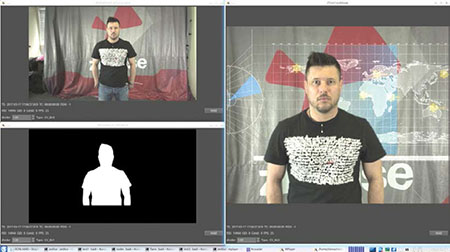
zLense three-dimensional zKey (3D) keying system
RENEWED VISION debuted its PVP3 playout device, which incorporates a best-in-class processing engine, allowing the device to serve as a video processor in addition to functioning as a media server and screen control system.
ZLENSE debuted a three-dimensional zKey (3D) keying system that uses the distance from the camera to determine the silhouette of the talent in real time, allowing the creation of the alpha channel or image mask without chroma or luma keying, with no special lighting required. With this approach, new options are possible for both creative executions and for operational and business tasks.
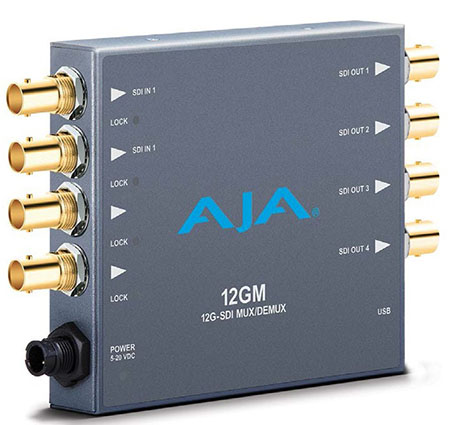
AJA’s 12GM 12G-SDI to/from 3G-SDI Muxer/DeMuxer
CONVERSION
AJA previewed its FS-HDR for HDR workflow conversion. Based on AJA’s flagship FS4, and incorporating the latest HDR technology Colorfront, FS-HDR provides HDR and Wide Color Gamut (WCG) processing and conversion for real time 4K/UHD and 2K/HD workflows.
Several new mini-converters also debuted at the show, including the 12GDA 12G/3G/SD-SDI Re-clocking Distribution Amplifier, a miniature 1x6 12G-SDI re-clocking distribution amplifier. Also new was the 12GM 12G-SDI to/from 3G-SDI Muxer/DeMuxer, a compact SDI transport converter that enables 12G-SDI to Quad 3G-SDI and Quad 3G-SDI to 12GSDI conversion. The company also introduced the FiDO Multi-Mode Fiber SFP Option that supports multi-mode fiber optic cable at distances up to 700M (OM4) or 300M (OM3).
For the IP environment, AJA launched a new line of IP receiver converters, which convert HD video to VSF TR-01 (and other JPEG2000 formats). IPT-1G-SDI provides one 3G-SDI input with a loopthrough SDI output, and IPT-1G-HDMI has a standard HDMI type A input.
COBALT DIGITAL unveiled its 9904-UXD- 4K format convertor that accommodates 4K video over a single 12 Gbps SDI connector, or processes four independent 3G SDI channels. Cobalt also demonstrated its new 9902-UXDDSP- CI Channel Integrator that provides signal processing and conversion to conform analog and digital A/V signals and associated metadata to meet channel delivery requirements. In addition, Cobalt showed their 9415- SFP openGear card for converting SDI to HDMI or vice-versa.
DECIMATOR DESIGN launched its MD-LX, an extra small, “lite” version of the company’s MD-HX bidirectional HDMI/SDI converter and scaler. Like the MD-HX, the MD-LX is a bidirectional HDMI/SDI converter for 3G-A/3G-B/HD/SD (minus the scaling/frame rate conversion available on the MD-HX).
EMBRIONIX displayed the emSFP Gateway, an HDMI/DVI to SDI video converter, which can convert from HDMI/DVI to SDI as well as SDI to HDMI. The Gateway has a 10GE port that can be used directly with 10GE video switchers and routers.
EVERTZ demonstrated their enhanced 7814UDX-4K line of UHD/3G/HD up/ down/cross conversion gear, which facilitate SDR/HDR conversions between several formats, including SDR, HLG, SMPTE-2084 and S.Log3. BT.709, BT.2020 and S.Gamut3 color space conversions are also accommodated.
FOR-A debuted the LMCC-8000 8K/4K linear matrix color convertor which was jointly developed with NHK. It converts between ITU-R BT.709 and ITU-R BT.2020 gamuts, and also accommodates dynamic range conversions.
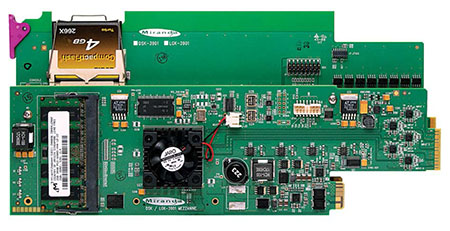
Grass Valley Densité 3
GRASS VALLEY unveiled its Densité 3 UHD-3901-UC dual-channel HD/3G to 4K UHD upconverter. The 4K UHD signals generated by the platform are output on quad link 3G SDI as per SMPTE ST-425-5 and supports two sample interleave and square division quad split outputs.
MULTIVIEWERS
APANTAC debuted their new MX-32-4KDP UHD multiviewer, which allows monitoring of up to 32 sources, including UHD/3G Level A and B/HD/SD-SDI video, and includes a custom on-screen display showing audio metering, custom labels and overlays, tallies and under-monitor displays.
COBALT DIGITAL introduced the 9971-MV-4K, a cost-effective option to drive professional-grade monitors and 4K prosumer/consumer monitors. All versions support six 12G-SDI inputs and there are options to expand the input count to 18x 12G-SDI, or add 4x HDMI 2.0 inputs.
DECIMATOR DESIGN unveiled its DMONQUAD, a low-cost one- to four-channel professional SDI multiviewer/quad-split with SDI and HDMI outputs for 3G-A/3G-B/HD/SD.
FOR-A spotlighted the MV-4300 multiviewer which accepts up to 68 inputs, provides eight outputs and accommodates SDI signals up to 12G, as well as DVI-A, HDMI and composite analog.
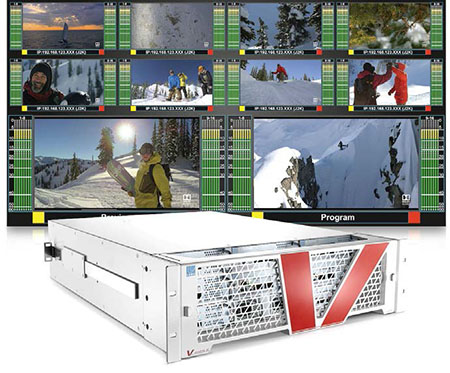
Lawo V__matrix Multiviewer
LAWO introduced the new V__matrix vm_mv24-4 and vm_mv16-4 virtual modules (VM), which add high-quality multiviewer functionality to the V__matrix ecosystem when loaded onto a c100 core processing module. Capable of handling both IP and SDI sources, these VMs can monitor uncompressed 4K/UHD, 3G, HD and SD video as well as both embedded and discrete audio while generating pixel-perfect mosaics with ultra-low latency.
MEDIAPROXY introduced some major updates to its Monwall multiviewer, including data monitoring panels for real-time analysis and monitoring of OTT streams, closed captions, DVB subtitles, loudness information and more.

Reidel’s MediorNet multiviewer app
RIEDEL introduced their new MediorNet multiviewer app that’s based on MediorNet MicroN high-density media distribution hardware. The app allows users to enable multiviewer hardware anywhere on the network that it’s needed, while at the same time removing additional hardware and complexity that would be required with a large router.
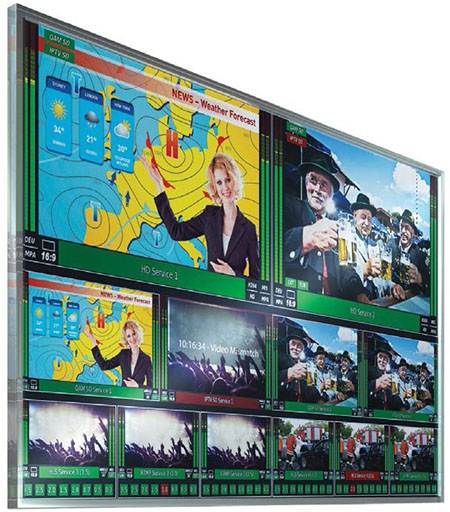
Rohde & Schwarz Prismon
ROHDE & SCHWARZ introduced the R&S software-based Prismon monitoring and multiviewing system for automatic monitoring transported broadcast and streaming media content while allowing for simultaneous viewing of multiple sources. It’s available for both standard IT platform applications and cloud-based systems.
SAM unveiled its Orbit next-generation applications, which include the MV-800-DT multiviewer and configuration application.
Get the TV Tech Newsletter
The professional video industry's #1 source for news, trends and product and tech information. Sign up below.
